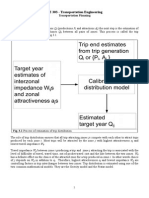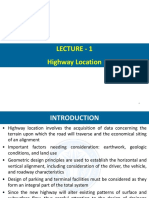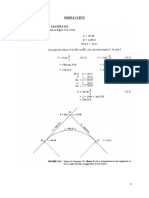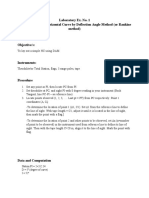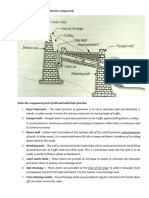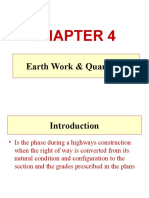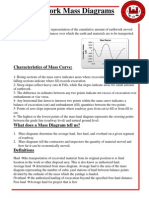0 ratings0% found this document useful (0 votes)
136 viewsAssignment #1
Assignment #1
Uploaded by
adanetiyoThis document outlines 8 questions for a soil mechanics assignment:
1. Calculate the void ratio and degree of saturation at two points on a compaction curve.
2. Determine the relative density of a soil deposit given its in-situ, maximum, and minimum void ratios.
3. Briefly explain the use of a plasticity chart in classifying fine-grained soils.
4. Calculate the ratio of horizontal to vertical permeability for a three-layer soil deposit where layer thicknesses and permeabilities increase stepwise.
5. Explain the difference between consolidation and compaction of soils.
Copyright:
© All Rights Reserved
Available Formats
Download as DOCX, PDF, TXT or read online from Scribd
Assignment #1
Assignment #1
Uploaded by
adanetiyo0 ratings0% found this document useful (0 votes)
136 views2 pagesThis document outlines 8 questions for a soil mechanics assignment:
1. Calculate the void ratio and degree of saturation at two points on a compaction curve.
2. Determine the relative density of a soil deposit given its in-situ, maximum, and minimum void ratios.
3. Briefly explain the use of a plasticity chart in classifying fine-grained soils.
4. Calculate the ratio of horizontal to vertical permeability for a three-layer soil deposit where layer thicknesses and permeabilities increase stepwise.
5. Explain the difference between consolidation and compaction of soils.
Original Title
Assignment #1 - Copy
Copyright
© © All Rights Reserved
Available Formats
DOCX, PDF, TXT or read online from Scribd
Share this document
Did you find this document useful?
Is this content inappropriate?
This document outlines 8 questions for a soil mechanics assignment:
1. Calculate the void ratio and degree of saturation at two points on a compaction curve.
2. Determine the relative density of a soil deposit given its in-situ, maximum, and minimum void ratios.
3. Briefly explain the use of a plasticity chart in classifying fine-grained soils.
4. Calculate the ratio of horizontal to vertical permeability for a three-layer soil deposit where layer thicknesses and permeabilities increase stepwise.
5. Explain the difference between consolidation and compaction of soils.
Copyright:
© All Rights Reserved
Available Formats
Download as DOCX, PDF, TXT or read online from Scribd
Download as docx, pdf, or txt
0 ratings0% found this document useful (0 votes)
136 views2 pagesAssignment #1
Assignment #1
Uploaded by
adanetiyoThis document outlines 8 questions for a soil mechanics assignment:
1. Calculate the void ratio and degree of saturation at two points on a compaction curve.
2. Determine the relative density of a soil deposit given its in-situ, maximum, and minimum void ratios.
3. Briefly explain the use of a plasticity chart in classifying fine-grained soils.
4. Calculate the ratio of horizontal to vertical permeability for a three-layer soil deposit where layer thicknesses and permeabilities increase stepwise.
5. Explain the difference between consolidation and compaction of soils.
Copyright:
© All Rights Reserved
Available Formats
Download as DOCX, PDF, TXT or read online from Scribd
Download as docx, pdf, or txt
You are on page 1of 2
Assignment #1
1. The result of laboratory compaction test is shown on the following figure
Calculate a) void ratio at point A and B
b)degree of saturation at point A and B take G= 2.7
2. The in-situ void ratio granular soil deposit is 0.5. Its maximum and minimum void ratio
are 0.5 and 0.35 respectively. Determine the relative density.
3. Briefly explain the use of plasticity chart in in calcifying fin grained soil.
4. Find the ratio of average ( equivalent ) permeability in the horizontal direction to that of
vertical direction of the soil deposit of three layers whose thickness ratio is 1:2:3.
Assume the permeability of the second layer is two times that of the first layer and
permeability of the third layer is three times that of the first layer.
5. Explain the difference between consolidation and compaction.
6. Three point load of 64, 16, and 20
tone, 2m apart in strait line act at the
surface of a soil mass. Calculate the
resultant stress produced at the depth
of 1.5m below 64 t load. The
Boussinesq’s influence value IB for
depth Z=1.5 m are given below with
respect to distance to depth (r/z) ratio
7. In a variable head permeability test the initial (t=0) hydraulic head is 45cm and it drops
1 cm in 5 minutes. Calculate the time required for the head dropped further by 10 cm i.e
from 44 cm to 34cm.
8. The ground water movement at a site takes place through a soil zone comprised of 3 m
thick with coefficient of permeability 0.01 cm/s (in both directions) overlain by 1 m thick
fine gravel with coefficient of permeability 0.1 cm/s (in both directions). Determine the
coefficient of permeability applicable for horizontal and vertical ground water
movements through the layer
You might also like
- Lecture 3 Trip DistributionDocument10 pagesLecture 3 Trip DistributionYimkum Ozzy100% (1)
- Unit 1.A. Geodetic Surveying: By. Piyush BhandariDocument18 pagesUnit 1.A. Geodetic Surveying: By. Piyush BhandariP K Jain100% (1)
- Question Paper - Endsem - CE F243Document8 pagesQuestion Paper - Endsem - CE F243Vinayaka RamNo ratings yet
- Assignments and Tutorials - Soil Mechanics - Spring NewDocument42 pagesAssignments and Tutorials - Soil Mechanics - Spring NewmanthanNo ratings yet
- HW-I CH2 Highway Route Surveys and LocationaaDocument29 pagesHW-I CH2 Highway Route Surveys and LocationaaYUlian TarikuNo ratings yet
- Chapter 3 Pavement DesignDocument22 pagesChapter 3 Pavement DesignAbdulmelik AdemNo ratings yet
- Chapter 5-Fundamental Principles of Traffic FlowDocument2 pagesChapter 5-Fundamental Principles of Traffic Flowzeru3261172No ratings yet
- 24 Mass Diagram Surveying ManualDocument3 pages24 Mass Diagram Surveying ManualNesya Laxmitha100% (1)
- Mid Exam For Do StudentDocument2 pagesMid Exam For Do StudentLeulNo ratings yet
- Chapter 3 Geometrical Design of HighwayDocument80 pagesChapter 3 Geometrical Design of HighwayKefene GurmessaNo ratings yet
- Interrupted Flow Facilities in Which External: Excessive DelaysDocument79 pagesInterrupted Flow Facilities in Which External: Excessive DelaysBashar ArshedNo ratings yet
- Chapt.5 Earthwork EXAMPLEDocument7 pagesChapt.5 Earthwork EXAMPLEabubekirNo ratings yet
- Highway Engineering-For CotmDocument96 pagesHighway Engineering-For CotmZeleke Taimu100% (1)
- Chapter Four Geometric Design of Highways: By: Wubamlak A. (MSC in Transportation Engineering)Document68 pagesChapter Four Geometric Design of Highways: By: Wubamlak A. (MSC in Transportation Engineering)Gadisa Tefera100% (1)
- HGD QP SolutionDocument68 pagesHGD QP Solutionmomin sialNo ratings yet
- Drainage and Drainage StructuresDocument20 pagesDrainage and Drainage StructuresJiregna ChalchisaNo ratings yet
- Lec 1 - Highway LocationDocument28 pagesLec 1 - Highway LocationJalal Habib KhanNo ratings yet
- Chapter 1 Introduction To Hydrology PDFDocument16 pagesChapter 1 Introduction To Hydrology PDFKimmieNo ratings yet
- Model Exit Exam On Road and Transpotion StreamDocument22 pagesModel Exit Exam On Road and Transpotion StreamTadesse MegersaNo ratings yet
- Chapter ThreeDocument23 pagesChapter Threeshambel asfawNo ratings yet
- Highway Engineering India BixDocument48 pagesHighway Engineering India BixRizwanNo ratings yet
- UNIVERSITY OF GONDAR CH-2 ExamplesDocument11 pagesUNIVERSITY OF GONDAR CH-2 Examplescherinet bisetegnNo ratings yet
- Route TD For All Student Learner's Highway EngineeringDocument25 pagesRoute TD For All Student Learner's Highway Engineeringkrishy19sNo ratings yet
- Assignmet 3 and 4 For Survey Oguti Thomas NDCE Otee Isaac NDCE Olila Denis NDAR QN1a) - State The Aid of The Two-Peg TestDocument7 pagesAssignmet 3 and 4 For Survey Oguti Thomas NDCE Otee Isaac NDCE Olila Denis NDAR QN1a) - State The Aid of The Two-Peg TestOtee IsaacNo ratings yet
- Laying Out Simple Horizontal Curve by Deflection Angle Method (Or Rankine Method)Document4 pagesLaying Out Simple Horizontal Curve by Deflection Angle Method (Or Rankine Method)Sasha Alicaway AugustoNo ratings yet
- 2020.highwaye NotesDocument110 pages2020.highwaye NotesEmmanuel AfedzieNo ratings yet
- Traffic Assighment 1Document11 pagesTraffic Assighment 1Gedion Woldesenbet100% (1)
- Trip Generation: Source: NHI Course On Travel Demand Forecasting (152054A)Document28 pagesTrip Generation: Source: NHI Course On Travel Demand Forecasting (152054A)Erickson Cauyao100% (1)
- Geometric Design of Highways: Tewodros NDocument36 pagesGeometric Design of Highways: Tewodros NPs Potchi ReddyNo ratings yet
- Worksheet No. 49: Definition of Leveling TermsDocument17 pagesWorksheet No. 49: Definition of Leveling TermsJohn Angelo CompetenteNo ratings yet
- Advance - Surveying ASSIGNMENTDocument8 pagesAdvance - Surveying ASSIGNMENTAmmar VanankNo ratings yet
- Sight DistancesDocument9 pagesSight DistancesJiregna Chalchisa100% (1)
- CE 3011 AstronomyDocument53 pagesCE 3011 AstronomyKyaw Zin HeinNo ratings yet
- Hydrograph, Stream Gauging and Peak Flood Estimation: Unit 2Document93 pagesHydrograph, Stream Gauging and Peak Flood Estimation: Unit 2amitpatilnitkNo ratings yet
- Civil Engineering ProgramDocument14 pagesCivil Engineering ProgramTadesse MegersaNo ratings yet
- Pavement Design Tutorial 1Document3 pagesPavement Design Tutorial 1biplov nepalNo ratings yet
- HW I Chapter 5 - Highway DrainageDocument43 pagesHW I Chapter 5 - Highway DrainageSolomon Desalegn100% (2)
- Problem Set (GD)Document4 pagesProblem Set (GD)yadoleNo ratings yet
- Ce123-Trip Generation and Attraction (Final)Document48 pagesCe123-Trip Generation and Attraction (Final)Vicces P. EstradaNo ratings yet
- HillDocument7 pagesHillAnkit KondilkarNo ratings yet
- Traffic Engineering-Lecture 4Document20 pagesTraffic Engineering-Lecture 4Ahmad SalihNo ratings yet
- Railway Curves 7Document21 pagesRailway Curves 7vpmohammedNo ratings yet
- Lecture 200999Document22 pagesLecture 200999Sidney MusondaNo ratings yet
- Highway Engineering Course Outline (CoTM) - 3rd YrDocument2 pagesHighway Engineering Course Outline (CoTM) - 3rd YrTarmok Hirpo100% (1)
- Ecv 401 Highway Engineering 1 - 2014Document32 pagesEcv 401 Highway Engineering 1 - 2014Daniel Kariuki100% (1)
- Pavement Design 18Cv825Document4 pagesPavement Design 18Cv825Yashodhar SrbNo ratings yet
- Multiple-Choice Test Runge-Kutta 4th Order Method: y X Xy DX DyDocument3 pagesMultiple-Choice Test Runge-Kutta 4th Order Method: y X Xy DX DyDr Razak Olusegun Alli-Oke100% (1)
- EarthworksDocument14 pagesEarthworkspaul macharia100% (1)
- HW-I CH4 Earth Work and Quantities NewDocument42 pagesHW-I CH4 Earth Work and Quantities NewYUlian Tariku100% (1)
- Average Rainfall MethodsDocument2 pagesAverage Rainfall MethodsBienvenida Ycoy Montenegro100% (1)
- 2B - Fundamentals of Traffic FlowDocument16 pages2B - Fundamentals of Traffic FlowKwasi Agyeman-BoakyeNo ratings yet
- Gps Mcq's - Set-1Document4 pagesGps Mcq's - Set-1p vinodreddyNo ratings yet
- Ceng 3182 Highway Engineering - I Mini - ProjectDocument2 pagesCeng 3182 Highway Engineering - I Mini - ProjectYefikir Sew Lpfe100% (1)
- Lecture 6-Geometric Design of Highways AnnotatedDocument80 pagesLecture 6-Geometric Design of Highways AnnotatedAntonio RojasAcunaNo ratings yet
- Example1 3Document7 pagesExample1 3MERIHUn100% (1)
- CH 12Document45 pagesCH 12hakamalramoniNo ratings yet
- Mass Haul DiagramDocument24 pagesMass Haul DiagramSuson DhitalNo ratings yet
- Chapter: One Geometric Design of Highways: Dr. Duraid M Abd Civil Engineering 2021Document145 pagesChapter: One Geometric Design of Highways: Dr. Duraid M Abd Civil Engineering 2021RasmiNo ratings yet
- Earthwork Mass Diagrams Moved2Document10 pagesEarthwork Mass Diagrams Moved2Shafiullah KhanNo ratings yet
- Tutorial#5Document2 pagesTutorial#5M FazilNo ratings yet
